Wikipedia:Picture of the day/May 2023
|
Featured picture tools: |
These featured pictures, as scheduled below, appeared as the picture of the day (POTD) on the English Wikipedia's Main Page in May 2023. Individual sections for each day on this page can be linked to with the day number as the anchor name (e.g. [[Wikipedia:Picture of the day/May 2023#1]] for May 1).
You can add an automatically updating POTD template to your user page using {{Pic of the day}} (version with blurb) or {{POTD}} (version without blurb). For instructions on how to make custom POTD layouts, see Wikipedia:Picture of the day.
May 1

|
The Divje Babe flute, also sometimes called the tidldibab or Neanderthal flute, is the femur of a cave bear, which is pierced by spaced holes similar to those found on a flute. The object was unearthed at Divje Babe I, a cave site near Cerkno in northwestern Slovenia in 1995, during systematic archaeological excavations in the area. It is possible that it was made by Neanderthals as a form of musical instrument, although this theory is debated by scientists: some argue that the holes in the bone were artificially made by Neanderthals, while others say they were made by carnivores. If confirmed as a musical instrument, it would be the oldest-known Paleolithic flute and musical instrument. The object is now in the collection of the National Museum of Slovenia in Ljubljana. Photograph credit: Petar Milošević
Recently featured:
|
May 2

|
The Panavia Tornado is a family of twin-engine multirole combat aircraft, jointly developed and manufactured by Italy, the United Kingdom and West Germany. There are three primary Tornado variants: the Tornado IDS fighter-bomber, the Tornado ECR suppression of enemy air defences aircraft and the Tornado ADV interceptor aircraft. Developed by Panavia Aircraft, it made its first flight in 1974 and entered service in 1979–80. The Tornado is used in active service by the German Air Force, the Italian Air Force, the Royal Saudi Air Force and was also used by the Royal Air Force (RAF) until 2019. This RAF Tornado GR4 was photographed in a training sortie over North West England in 2012. Photograph credit: Mike Jones
Recently featured:
|
May 3
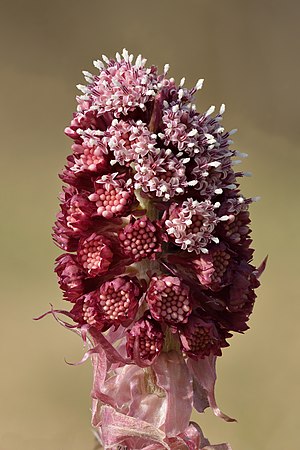
|
Petasites hybridus, the butterbur, is a species of herbaceous perennial flowering plant in the family Asteraceae native to Europe and northern Asia. Although used over centuries in traditional medicine to treat various disorders and sometimes sold as a dietary supplement, it has no approved medical uses. Concerns about the potential toxic effects of pyrrolizidine alkaloids limit its use in human and animal studies. This P. hybridus inflorescence was photographed in a forest near Keila in northwestern Estonia. Photograph credit: Ivar Leidus
Recently featured:
|
May 4
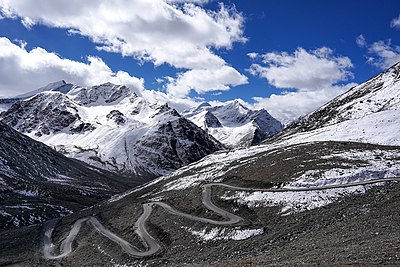
|
Shingo La is a high-altitude mountain pass in the Himalayas in northern India, connecting the Lahaul region of Himachal Pradesh with the Zanskar region of Ladakh. The pass is located at an altitude of about 5,000 metres (16,000 ft) and becomes snowbound in the winter months. This photograph, taken in October 2022, depicts the Nimmu–Padum–Darcha road winding through the pass. Photograph credit: Timothy Gonsalves
Recently featured:
|
May 5

|
|
The InSight mission was a robotic lander. It was manufactured by Lockheed Martin Space, managed by NASA's Jet Propulsion Laboratory (JPL), and two of its three scientific instruments were built by Europeans agencies. The mission launched on 5 May 2018 aboard an Atlas V-401 launch vehicle and successfully landed at Elysium Planitia on Mars on 26 November 2018. Photograph credit: NASA, JPL-Caltech, Lockheed Martin
Recently featured:
|
May 6

|
His Majesty is an 1897 comic opera with dialogue by F. C. Burnand, lyrics by R. C. Lehmann, additional lyrics by Adrian Ross, and music by Alexander Mackenzie. The work premiered at the Savoy Theatre in London on 20 February 1897, running for only 61 performances until 24 April, despite a strong cast including George Grossmith, Ilka Pálmay, Scott Russell, Fred Billington, Florence Perry and Walter Passmore. The D'Oyly Carte Opera Company then toured the opera throughout 1897 alongside more familiar Gilbert and Sullivan works. This poster for His Majesty was designed by Dudley Hardy to advertise the original D'Oyly Carte production, or the tour immediately following. Poster credit: Dudley Hardy; restored by Adam Cuerden
Recently featured:
|
May 7
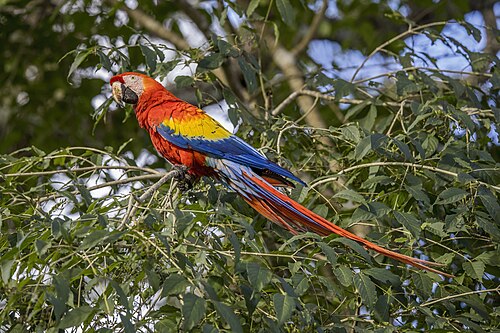
|
|
The scarlet macaw (Ara macao) is a large parrot, a member of a large group of Neotropical parrots called macaws. Its range extends from south-eastern Mexico to Peru, Ecuador, Colombia, Bolivia, Venezuela and Brazil in lowlands of up to 1,000 m (3,300 ft), the Caribbean island of Trinidad, as well as the Pacific island of Coiba. Photograph credit: Charles J. Sharp
Recently featured:
|
May 8

|
Abhayagiri Vihāra was a major monastery site of Mahayana, Theravada and Vajrayana Buddhism located in Anuradhapura, Sri Lanka. This photograph depicts the monastery's stupa as seen in 2020. Photograph credit: A. Savin
Recently featured:
|
May 9
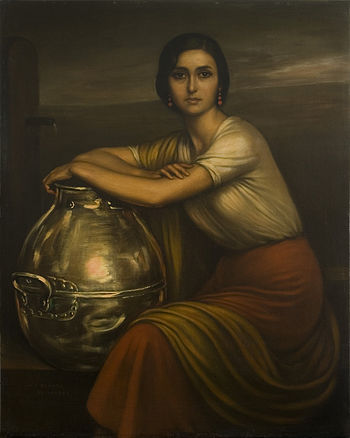
|
La Fuensanta is a portrait painting by Spanish artist Julio Romero de Torres depicting Maria Teresa López González, one of his models. The painting was made in the autumn of 1929, when Torres completed another two artworks, La Chiquita Piconera and Bodegas Cruz Conde. González was one of Torres's favourite models, having first sat for him at the age of fourteen. According to Sotheby's, the work has been "proclaimed as a quintessential rendition of Andalucian beauty", and it was depicted for 25 years on the 100 peseta banknote. The work was exhibited at the Ibero-American Exposition in Seville in 1930, and is now in a private collection. Painting credit: Julio Romero de Torres
Recently featured:
|
May 10
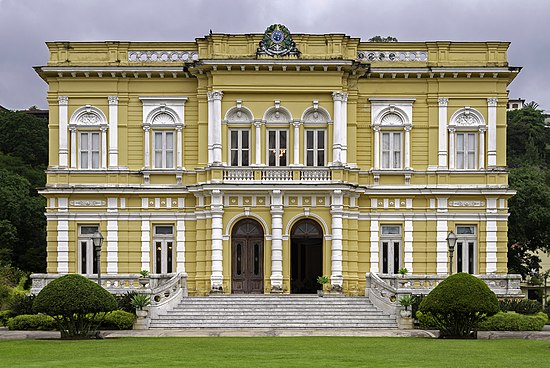
|
|
The Palácio Rio Negro is a palace in Petrópolis in the state of Rio de Janeiro, Brazil. One of the official residences of the president of Brazil, it is used mainly as a country retreat. The palace was designed by the Italian architect Antonio Jannuzzi in 1889 and built in the same year as a summer residence for Manuel Gomes de Carvalho, Baron of Rio Negro. He moved to Paris in 1894, leaving the building empty, and in February 1896 the palace and adjacent buildings were sold to the state of Rio de Janeiro to serve as the official residence of the state governor. It was then acquired by the federal government of Brazil in 1903, becoming the official presidential summer residence. This photograph depicts the façade of the Palácio Rio Negro in 2015. Photograph credit: Wilfredor
Recently featured:
|
May 11

|
Pinnularia is a genus of freshwater algae in the class Bacillariophyceae, the diatoms. An elongated elliptical unicellular organism, it is usually found in ponds and moist soil. The cell walls are composed chiefly of pectic substances on a rigid silica framework, and are composed of two halves known as thecae (or, less formally, valves). This Pinnularia major specimen, about 0.3 millimetres (0.012 in) in length, was photographed through a light microscope. Photograph credit: Anatoly Mikhaltsov
Recently featured:
|
May 12
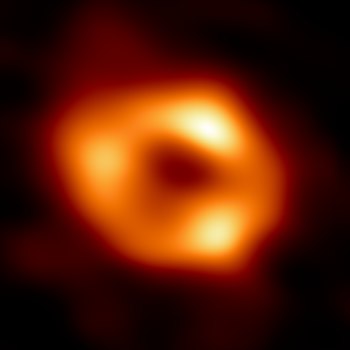
|
Sagittarius A* is the supermassive black hole at the Galactic Center of the Milky Way. It is located near the border of the constellations Sagittarius and Scorpius, about 5.6 degrees south of the ecliptic, visually close to the Butterfly Cluster and Lambda Scorpii. On May 12, 2022, astronomers released this first image of the accretion disk around the event horizon of Sagittarius A*, produced in April 2017 by the Event Horizon Telescope (EHT), a worldwide network of radio observatories, confirming the object to be a black hole. This was the second confirmed image of a black hole, after EHT's image of M87* released in 2019. Image credit: EHT Collaboration
Recently featured:
|
May 13
|
The General is a 1926 American silent film released by United Artists. It was inspired by the Great Locomotive Chase, a true story of an event that occurred during the American Civil War. The story was adapted from the 1889 memoir The Great Locomotive Chase by William Pittenger. The film stars Buster Keaton in the leading role; Keaton co-directed it with Clyde Bruckman. The General was not well received by critics or audiences at the time of its release, but it has since been reevaluated and is now often ranked among the greatest American films. Film credit: United Artists
Recently featured:
|
May 14

|
The Belle Tout Lighthouse is a decommissioned lighthouse and British landmark located at Beachy Head, East Sussex, close to the town of Eastbourne. The cliffs near Beachy Head saw numerous shipwrecks in the 17th and early 18th centuries and a petition to erect a lighthouse started around 1691. Despite this, the lighthouse was not built until 1828, initially as a temporary wooden structure, and then as a permanent granite lighthouse which was designed by Thomas Stevenson and became operational in 1834. The light was provided by a three-sided rotating array of oil lamps with ten lamps on each side, each lamp mounted within a parabolic reflector. The Belle Tout lighthouse was decommissioned in 1902, when the replacement Beachy Head Lighthouse was built at the bottom of the cliffs. In 1999, the Grade II listed building was moved in one piece to prevent it from succumbing to coastal erosion, and since 2010 it has operated as a bed and breakfast. Photograph credit: Kallerna
Recently featured:
|
May 15

|
Lestes sponsa, also known as the emerald damselfly or the common spreadwing, is a species of damselfly in the family Lestidae. It has a wide Palaearctic distribution and resides near pools with aquatic plants. Both males and females have a metallic green colour and brown wing spots. This male L. sponsa damselfly was photographed at Warren Heath in Hampshire, England. Photograph credit: Charles J. Sharp
Recently featured:
|
May 16

|
|
Alsace–Lorraine, now known as Alsace–Moselle, is a historical region in modern-day France. It was created by the German Empire in 1871, after it had seized the region from France in the Franco-Prussian War with the Treaty of Frankfurt and forced France to pay an indemnity of five billion francs. Anger in the French Third Republic about the loss of the territory was one of the contributing factors that led to World War I, and the region reverted to France in 1918 as part of the Treaty of Versailles and Germany's defeat in the war. This oil-on-canvas painting, titled The Geography Lesson or The Black Spot, was painted around 1887 by Albert Bettannier. It depicts a school teacher showing pupils a map of France in which Alsace–Lorraine is coloured black, portraying French resentment of the loss of the region to Germany. The painting is in the collection of the German Historical Museum in Berlin. Painting credit: Albert Bettannier
Recently featured:
|
May 17

|
Samantha Cristoforetti (born 1977) is an Italian European Space Agency astronaut, former Italian Air Force pilot and engineer. She holds the record for the longest uninterrupted spaceflight by a European astronaut (199 days, 16 hours), and she held the record for the longest single space flight by a woman until this was broken by Peggy Whitson in June 2017. She is also the first Italian woman in space. She took command of ISS Expedition 68 on 28 September 2022. This official photographic portrait of Cristoforetti wearing an Extravehicular Mobility Unit spacesuit was taken in 2013. Photograph credit: Robert Markowitz
Recently featured:
|
May 18

|
Kumquats are a group of small fruit-bearing trees in the flowering plant family Rutaceae. Their taxonomy is disputed. They were previously classified as forming the now-historical genus Fortunella or placed within the genus Citrus, sensu lato. Different classifications have alternatively assigned them to anywhere from a single species, C. japonica, to numerous species representing each cultivar. This photograph, depicting one halved and two whole kumquats, was focus-stacked from 22 separate images. Photograph credit: Ivar Leidus
Recently featured:
|
May 19
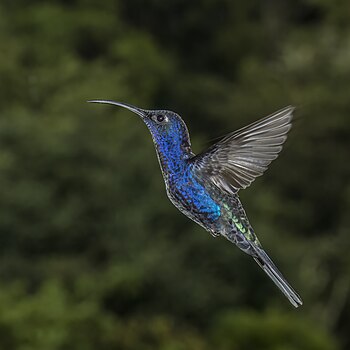
|
The violet sabrewing (Campylopterus hemileucurus) is a species of hummingbird in the tribe Trochilini, sometimes known as the emeralds. It is the largest hummingbird of Mexico and Central America, being 13 to 15 centimetres (5 to 6 in) long with a weight of 9 to 12 grams (0.3 to 0.4 oz). Both sexes have a black bill. There are two subspecies, C. h. hemileucurus and C. h. mellitus. This male C. h. mellitus violet sabrewing in flight was photographed in the Mount Totumas cloud forest in Panama. Photograph credit: Charles J. Sharp
Recently featured:
|
May 20

|
Sándor Vay (1859–1918) was a Hungarian poet and journalist. Born as a female named Sarolta, Vay was one of the first Hungarian women to complete university studies. Vay then began identifying as a male journalist, both before and after the sensational trial for his marriage to another woman in 1889. The case drew the attention of noted sexologists of the period, including Havelock Ellis and Richard von Krafft-Ebing, who used it to explore female inversion in the emerging field of sexology. During his lifetime, he was well respected as an author of historical articles on notable figures and cultural topics related to Hungary. Many of his works have been posthumously republished and are considered an important part of his country's literary heritage. Unknown author; restored by Adam Cuerden
Recently featured:
|
May 21

|
|
The Sleeping Gypsy is an 1897 oil-on-canvas by the French Naïve artist Henri Rousseau. It is a fantastical depiction of a lion musing over a sleeping woman on a moonlit night. Rousseau first exhibited the painting at the 13th Salon des Indépendants, and tried unsuccessfully to sell it to the mayor of his hometown, Laval. It instead entered the private collection of a Parisian charcoal merchant, where it remained until 1924, when it was discovered by the art critic Louis Vauxcelles. The Paris-based art dealer Daniel-Henry Kahnweiler purchased the painting in 1924, although a controversy arose over whether the painting was a forgery. It was acquired by art historian Alfred H. Barr Jr. for the Museum of Modern Art in New York, where it remains. Painting credit: Henri Rousseau
Recently featured:
|
May 22
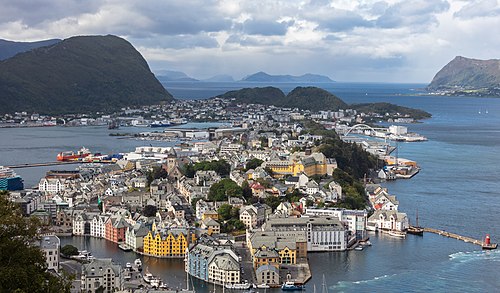
|
|
Ålesund is a town and municipality in Møre og Romsdal county, Norway. The centre of the town lies on the islands of Hessa, Aspøya, and Nørvøya with newer developments located on the island of Oksenøya. According to local legend, Ålesund was founded by Gangerolf (Rollo), in the 9th century, and in 1848 it was given the status of a town. In 1904, the town was largely destroyed in a fire and subsequently rebuilt, with most of the buildings constructed of stone in Art Nouveau style. This photograph depicts a view of Ålesund in September 2019 as seen from Aksla, a viewpoint over the town. Photograph credit: Diego Delso
Recently featured:
|
May 23

|
|
Vanadinite is a mineral belonging to the apatite group of phosphates. It is one of the main industrial ores of the metal vanadium and a minor source of lead. A dense, brittle mineral, it is usually found in the form of red hexagonal crystals. It is an uncommon mineral, formed by the oxidation of lead ore deposits such as galena. First discovered in 1801 in Mexico, vanadinite deposits have since been unearthed in South America, Europe, Africa, and North America. This cluster of reddish brown tabular vanadinite crystals, measuring 4.0 cm × 2.5 cm × 2.3 cm (1.57 in × 0.98 in × 0.91 in), was found in a mine in Mibladen, Morocco. The photograph was focus-stacked from 212 separate images using software. Photograph credit: Ivar Leidus
Recently featured:
|
May 24

|
K. Sukumaran is an Indian lawyer who has served as a judge in the high courts of Kerala and Mumbai in India. He has led several inquiries into human rights abuses. He is the author of several books on legal topics. This photograph of Sukumaran was taken in 2020. Photograph credit: Augustus Binu
Recently featured:
|
May 25

|
Chichester Cathedral is an Anglican church in Chichester, West Sussex, England. It was founded as a cathedral in 1075, when the seat of the bishop was moved from Selsey. The cathedral has architecture in both the Norman and the Gothic styles, with two architectural features that are unique among England's medieval cathedrals—a free-standing medieval bell tower (or campanile) and double aisles. The cathedral contains two rare medieval sculptures and many modern art works including tapestries, stained glass and sculpture. This westward view shows the cathedral's choir, which is separated from the nave by a pulpitum with three arched openings, called the Arundel Screen. Photograph credit: David Iliff
Recently featured:
|
May 26

|
|
Thyroid hormones are hormones produced and released by the thyroid gland, namely triiodothyronine (T3) and thyroxine (T4). They are tyrosine-based hormones that are primarily responsible for regulation of metabolism. T3 and T4 are partially composed of iodine, derived from food. A deficiency of iodine leads to decreased production of T3 and T4, enlarges the thyroid tissue and will cause the disease known as simple goitre. This illustration shows the synthesis of thyroid hormones, as seen on an individual thyroid follicular cell. Illustration credit: Mikael Häggström
Recently featured:
|
May 27

|
|
The Eurasian brown bear (Ursus arctos arctos) is one of the most common subspecies of the brown bear, and is found in much of Eurasia. It is also called the European brown bear, common brown bear, common bear, and colloquially by many other names. The genetic diversity of present-day brown bears (Ursus arctos) has been extensively studied over the years and appears to be geographically structured into five main clades based upon analysis of the mitochondrial DNA. This adult female was photographed near Stari Kot, Slovenia. Photograph credit: Charles J. Sharp
Recently featured:
|
May 28

|
The Head of Bhairava is a 16th-century mask from the Kathmandu Valley in Nepal. Made of gilt copper with rock crystal and paint during Nepal's Malla period, it depicts Bhairava, the destructive and terrifying manifestation of the Hindu god Shiva. The mask is in the Metropolitan Museum of Art in New York. Photograph credit: Metropolitan Museum of Art
Recently featured:
|
May 29

|
|
Mount Everest is Earth's highest mountain above sea level, located in the Himalayas along the China–Nepal border. Its summit, at 8,848.86 m (29,031.7 ft) elevation, was first reached on 29 May 1953 by Tenzing Norgay and Edmund Hillary. This map, which uses data from the US National Snow and Ice Data Center, is a 3D rendering of Mount Everest and its surrounding terrain. Features portrayed on the map include the Khumbu Icefall, the South Base Camp (5,300 m), Nuptse (7,861 m) and Lhotse (8,516 m). Map credit: Tom Patterson
Recently featured:
|
May 30
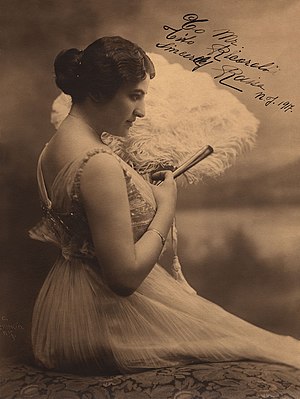
|
Rosa Raisa (30 May 1893 – 28 September 1963) was a Polish-born and Italian-trained Russian-Jewish dramatic operatic soprano who became a naturalized American. She possessed a voice of remarkable power and was the creator of the title role of Puccini's last opera, Turandot, at La Scala in Milan. This photograph of Raisa, which she autographed in 1917, was taken by Herman Mishkin, a Russian-American photographer who specialized in photographing opera singers. Photograph credit: Herman Mishkin; restored by Adam Cuerden
Recently featured:
|
May 31

|
Valerian (Valeriana officinalis) is a perennial flowering plant in the family Caprifoliaceae, native to Europe and Asia. In the summer when the mature plant may have a height of 1.5 metres (5 feet), it bears sweetly scented pink or white flowers that attract many fly species, especially hoverflies of the genus Eristalis. Valerian has been used as a herb in traditional medicine since at least the time of ancient Greece and Rome; Hippocrates described its properties and Galen later prescribed it as a remedy for insomnia. This valerian flower was photographed in Niitvälja, Estonia, in 2021. Photograph credit: Ivar Leidus
Recently featured:
|
Picture of the day archives and future dates
